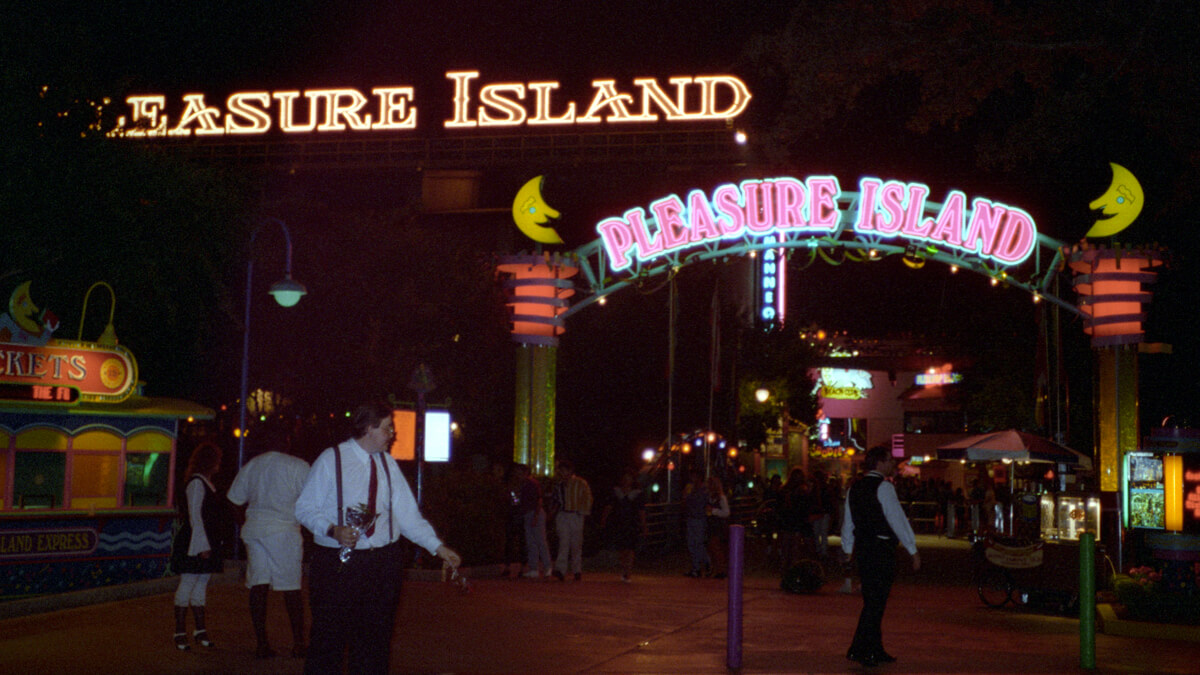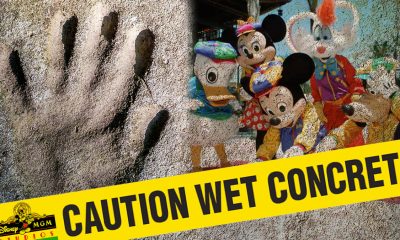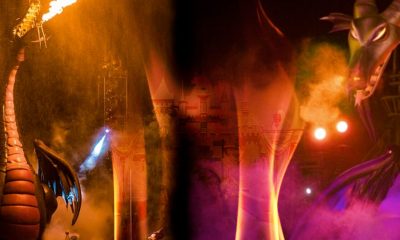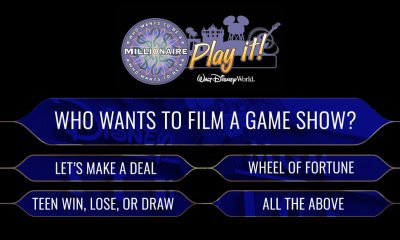
So what’s your favorite club at Walt Disney World’s Pleasure Island?
Me? Though I do enjoy an occasional visit to the Comedy Warehouse, I have to admit that I’m mostly an Adventurer’s Club fan. I mean, I can’t tell you the number of times that I’ve found myself in the Library, watching as Professor Otis Wren, Hathaway Browne and Emil Bleehall all compete for the Blanderdash Cup.
One of my favorite moments in that particular Adventurer’s Club show comes when Professor Wren is spinning out his fish tale. When Otis comes to the part in his story where his boat is destroyed by a typhoon, the ship-in-the-bottle that’s on the bar directly behind this performer suddenly sinks. It’s a bit of stage business that never fails to get a laugh out of audiences attending the Balderdash Cup.
But me? I can’t help but look at that sinking ship-in-a-bottle bit and get a little wistful. Why for? Because I can’t help but think: “Wouldn’t that effect have played better in the Pleasure Island Club that the Imagineers had originally intended it for, Madison’s Dive?”
What’s that? You’ve never heard of Madison’s Dive? The nightclub that was originally announced for Disney’s World’s Pleasure Island but ultimately never built. The one that was supposed to have been loaded with all these salty old sailors who would win spin out these amazing yarns. The club that was to have had a sunken bar that featured a window that looked directly out into the depths of Lake Buena Vista. Where — every so often — a real live mermaid would have swum by the window.
Yeah, Madison’s Dive would have been a pretty amazing addition to PI’s line-up. So why — after announcing such a wonderful sounding establishment as part of Pleasure Island’s initial line-up — didn’t the Imagineers actually go forward with construction of this club.
Because … well … Pleasure Island went over budget. WAY over budget. How over budget? Over 150%, according to one WDI memo that I’ve seen. This Walt Disney World nightclub project got totally out of control during its initial design phase. With the Imagineers adding all sorts of bells and whistles, with the hope that this new WDW nightclub complex would eventually prove to be a bigger draw with tourists than the already opened Rosie O’Grady’s Goodtime Emporium in downtown Orlando.
And — once Disney management got wind of how far out of control (financially, that is) the Pleasure Island project was — they immediately asked the Imagineers to make some concessions. To rein this WDW project in.
Sadly, one of the things that eventually fell by the wayside was Madison’s Dive. After carefully review their plans for Disney World’s new nightclub complex, the Imagineers felt that — given that PI already had one nightclub which would be loaded with story tellers and special effects (AKA The Adventurer’s Club) — there was no need to Pleasure Island to repeat itself. Which is why Madison’s Dive eventually got deep sixed.
Now … where this gets interesting is Madison’s Dive was actually Michael Eisner’s favorite nightclub out of all those that were proposed for Pleasure Island. Why for? Well, you have to understand that Disney’s CEO had a thing for mermaids. Particular Madison, the mermaid character that was featured so prominently in the 1984 Touchstone Pictures’ release, “Splash.”
Why did Michael have a thing for Madison? Well, you have understand that — when Eisner first came on board at the Walt Disney Company in September 1984 — “Splash” was the biggest hit that the Mouse House had had in years, grossing over $69 million during its initial domestic run.
And — given that Michael had come to Walt Disney Studios from Paramount Pictures (AKA Hollywood’s home of the sequel. Witness “Grease II,” “Beverly Hills Cop II,” “Indiana Jones and the Temple of Doom” and “Star Trek II, III and IV”) — Eisner was determined that Disney should soon get in the sequel business as well.
So one of the very first things that Michael did — as soon as he arrived at the Mouse House — was immediately put a sequel in the works for the studio’s highest grossing animated film. Which — at that time — was Walt Disney Productions’ 1977 release, “The Rescuers.” Eisner then also ordered that Disney hire a few screenwriters to get started on a script for a “Splash” sequel.
The only problem was … no one — outside of Michael, that is — was all that eager to do a “Splash” sequel. Not the film’s director, Ron Howard. Not the movie’s stars, Tom Hanks and Daryl Hannah. These folks all wanted to move onto new projects, rather than revisit the characters that they’d created for the popular fantasy romance.
Still, Eisner persisted. And — when he couldn’t get any of the film’s creative team to return — Michael opted to have his “Splash” sequel produced as a TV movie instead. “Splash, Too” (With Todd Waring in the Tom Hanks role and Amy Yasbeck slipping into Daryl Hannah’s tail) aired as a two part installment of ABC’s “Disney Sunday Night Movie” program back on May 1st and 8th, 1988. (Here’s an intriguing bit of trivia for all you Disneyana fans. “Splash, Too” was the first movie ever to be filmed at the then-new Disney-MGM Studio complex.)
Anyway … Back in the mid-1980s, Eisner truly seemed desperate to find ways to shoehorn “Splash”‘s characters into other Disney projects. Even going so far as to suggest that the Imagineers who were then working on Disneyland’s still-in-the-planning-stages “Splash Mountain” project to find a way for Madison to make a cameo appearance among all those critters from “Song of the South.”
Obviously, the guys at WDI chose to ignore this particular request from Disney’s CEO. But the Imagineers never forgot that Michael Eisner really did seem obsessed with the Madison character from “Splash.” Which was why — as they were putting together their plans for Pleasure Island — the folks who working on this WDW nightclub project thought: “If we really want to make sure that Michael will greenlight PI, we should make sure that at least one of these nightclubs prominently features the mermaid from ‘Splash.'”
Which is why — of course — Madison’s Dive ended up as one of the most prominent featured clubs in the original site plan for Disney World’s Pleasure Island. Concept art that I’ve seen shows that this particular nightclub was to have been built on a pier that would have jutted out into Lake Buena Vista between the Adventurer’s Club and the XZFR Rockin’ Rollerdrome.
But — as the costs of actually constructing Pleasure Island began spiraling out of control (more importantly, given that the “Splash, Too” TV movie had turned out to be such a dud) — Michael Eisner began losing his enthusiasm for the whole “Madison’s Dive” nightclub idea. And — given that this PI club (what with its special built-out-on-a-pier locations as well as all of its below-the-waterline special effects) was going to be the most expensive one of the bunch to complete — that’s why “Madison’s Dive” was the first nightclub to get cut as Pleasure Island went under the budgetary knife.
But even so, there were Imagineers assigned to the PI project who just loved the whole idea of “Madison’s Dive.” Which was why — even after this nightclub got cut — they tried to shoehorn little bits and pieces of this nautically themed nightspot into the Adventurer’s Club.
Which is why that ship-in-the-bottle gag (a bit of business that was originally written for one of the shows that was to have to been presented nightly at “Madison’s Dive”) wound up being part of Professor Otis Wren’s fish tale in his portion of the Balderdash Cup competition. As sort of a sly WDI tribute to the nightclub that never quite made it off the drawing board.
So what do you think of this fishy tale? Your thoughts?

History
The Evolution and History of Mickey’s ToonTown

Disneyland in Anaheim, California, holds a special place in the hearts of Disney fans worldwide, I mean heck, it’s where the magic began after all. Over the years it’s become a place that people visit in search of memorable experiences. One fan favorite area of the park is Mickey’s Toontown, a unique land that lets guests step right into the colorful, “Toony” world of Disney animation. With the recent reimagining of the land and the introduction of Micky and Minnies Runaway Railway, have you ever wondered how this land came to be?
There is a fascinating backstory of how Mickey’s Toontown came into existence. It’s a tale of strategic vision, the influence of Disney executives, and a commitment to meeting the needs of Disney’s valued guests.
The Beginning: Mickey’s Birthdayland
The story of Mickey’s Toontown starts with Mickey’s Birthdayland at Walt Disney World’s Magic Kingdom. Opened in 1988 to celebrate Mickey Mouse’s 60th birthday, this temporary attraction was met with such overwhelming popularity that it inspired Disney executives to think bigger. The idea was to create a permanent, immersive land where guests could step into the animated world of Mickey Mouse and his friends.
In the early ’90s, Disneyland was in need of a refresh. Michael Eisner, the visionary leader of The Walt Disney Company at the time, had an audacious idea: create a brand-new land in Disneyland that would celebrate Disney characters in a whole new way. This was the birth of Mickey’s Toontown.
Initially, Disney’s creative minds toyed with various concepts, including the idea of crafting a 100-Acre Woods or a land inspired by the Muppets. However, the turning point came when they considered the success of “Who Framed Roger Rabbit.” This film’s popularity and the desire to capitalize on contemporary trends set the stage for Toontown’s creation.
From Concept to Reality: The Birth of Toontown
In 1993, Mickey’s Toontown opened its gates at Disneyland, marking the first time in Disney Park history where guests could experience a fully realized, three-dimensional world of animation. This new land was not just a collection of attractions but a living, breathing community where Disney characters “lived,” worked, and played.
Building Challenges: Innovative Solutions
The design of Mickey’s Toontown broke new ground in theme park aesthetics. Imagineers were tasked with bringing the two-dimensional world of cartoons into a three-dimensional space. This led to the creation of over 2000 custom-built props and structures that embodied the ‘squash and stretch’ principle of animation, giving Toontown its distinctiveness.
And then there was also the challenge of hiding the Team Disney Anaheim building, which bore a striking resemblance to a giant hotdog. The Imagineers had to think creatively, using balloon tests and imaginative landscaping to seamlessly integrate Toontown into the larger park.

Key Attractions: Bringing Animation to Life
Mickey’s Toontown featured several groundbreaking attractions. “Roger Rabbit’s Car Toon Spin,” inspired by the movie “Who Framed Roger Rabbit,” became a staple of Toontown, offering an innovative ride experience. Gadget’s Go-Coaster, though initially conceived as a Rescue Rangers-themed ride, became a hit with younger visitors, proving that innovative design could create memorable experiences for all ages.
Another crown jewel of Toontown is Mickey’s House, a walkthrough attraction that allowed guests to explore the home of Mickey Mouse himself. This attraction was more than just a house; it was a carefully crafted piece of Disney lore. The house was designed in the American Craftsman style, reflecting the era when Mickey would have theoretically purchased his first home in Hollywood. The attention to detail was meticulous, with over 2000 hand-crafted, custom-built props, ensuring that every corner of the house was brimming with character and charm. Interestingly, the design of Mickey’s House was inspired by a real home in Wichita Falls, making it a unique blend of real-world inspiration and Disney magic.
Mickey’s House also showcased Disney’s commitment to creating interactive and engaging experiences. Guests could make themselves at home, sitting in Mickey’s chair, listening to the radio, and exploring the many mementos and references to Mickey’s animated adventures throughout the years. This approach to attraction design – where storytelling and interactivity merged seamlessly – was a defining characteristic of ToonTown’s success.

Executive Decisions: Shaping ToonTown’s Unique Attractions
The development of Mickey’s Toontown wasn’t just about creative imagination; it was significantly influenced by strategic decisions from Disney executives. One notable input came from Jeffrey Katzenberg, who suggested incorporating a Rescue Rangers-themed ride. This idea was a reflection of the broader Disney strategy to integrate popular contemporary characters and themes into the park, ensuring that the attractions remained relevant and engaging for visitors.
In addition to Katzenberg’s influence, Frank Wells, the then-President of The Walt Disney Company, played a key role in the strategic launch of Toontown’s attractions. His decision to delay the opening of “Roger Rabbit’s Car Toon Spin” until a year after Toontown’s debut was a calculated move. It was designed to maintain public interest in the park by offering new experiences over time, thereby giving guests more reasons to return to Disneyland.
These executive decisions highlight the careful planning and foresight that went into making Toontown a dynamic and continuously appealing part of Disneyland. By integrating current trends and strategically planning the rollout of attractions, Disney executives ensured that Toontown would not only capture the hearts of visitors upon its opening but would continue to draw them back for new experiences in the years to follow.
Global Influence: Toontown’s Worldwide Appeal
The concept of Mickey’s Toontown resonated so strongly that it was replicated at Tokyo Disneyland and influenced elements in Disneyland Paris and Hong Kong Disneyland. Each park’s version of Toontown maintained the core essence of the original while adapting to its cultural and logistical environment.
Evolution and Reimagining: Toontown Today
As we approach the present day, Mickey’s Toontown has recently undergone a significant reimagining to welcome “Mickey & Minnie’s Runaway Railway” in 2023. This refurbishment aimed to enhance the land’s interactivity and appeal to a new generation of Disney fans, all while retaining the charm that has made ToonTown a beloved destination for nearly three decades.

Dive Deeper into ToonTown’s Story
Want to know more about Mickey’s Toontown and hear some fascinating behind-the-scenes stories, then check out the latest episode of Disney Unpacked on Patreon @JimHillMedia. In this episode, the main Imagineer who worked on the Toontown project shares lots of interesting stories and details that you can’t find anywhere else. It’s full of great information and fun facts, so be sure to give it a listen!
History
Unpacking the History of the Pixar Place Hotel

Pixar Place Hotel, the newly unveiled 15-story tower at the Disneyland Resort, has been making waves in the Disney community. With its unique Pixar-themed design, it promises to be a favorite among visitors.
However, before we delve into this exciting addition to the Disneyland Resort, let’s take a look at the fascinating history of this remarkable hotel.
The Emergence of the Disneyland Hotel
To truly appreciate the story of the Pixar Place Hotel, we must turn back the clock to the early days of Disneyland. While Walt Disney had the visionary ideas and funding to create the iconic theme park, he faced a challenge when it came to providing accommodations for the park’s visitors. This is where his friend Jack Wrather enters the picture.
Jack Wrather, a fellow pioneer in the television industry, stepped in to assist Walt Disney in realizing his dream. Thanks to the success of the “Lassie” TV show produced by Wrather’s company, he had the financial means to build a hotel right across from Disneyland.
The result was the Disneyland Hotel, which opened its doors in October 1955. Interestingly, the early incarnation of this hotel had more of a motel feel than a hotel, with two-story buildings reminiscent of the roadside motels popular during the 1950s. The initial Disneyland Hotel consisted of modest structures that catered to visitors looking for affordable lodging close to the park. While the rooms were basic, it marked the beginning of something extraordinary.
The Evolution: From Emerald of Anaheim to Paradise Pier
As Disneyland’s popularity continued to soar, so did the demand for expansion and improved accommodations. In 1962, the addition of an 11-story tower transformed the Disneyland Hotel, marking a significant transition from a motel to a full-fledged hotel.
The addition of the 11-story tower elevated the Disneyland Hotel into a more prominent presence on the Anaheim skyline. At the time, it was the tallest structure in all of Orange County. The hotel’s prime location across from Disneyland made it an ideal choice for visitors. With the introduction of the monorail linking the park and the hotel, accessibility became even more convenient. Unique features like the Japanese-themed reflecting pools added to the hotel’s charm, reflecting a cultural influence that extended beyond Disney’s borders.
Japanese Tourism and Its Impact
During the 1960s and 1970s, Disneyland was attracting visitors from all corners of the world, including Japan. A significant number of Japanese tourists flocked to Anaheim to experience Walt Disney’s creation. To cater to this growing market, it wasn’t just the Disneyland Hotel that aimed to capture the attention of Japanese tourists. The Japanese Village in Buena Park, inspired by a similar attraction in Nara, Japan, was another significant spot.
These attractions sought to provide a taste of Japanese culture and hospitality, showcasing elements like tea ceremonies and beautiful ponds with rare carp and black swans. However, the Japanese Village closed its doors in 1975, likely due to the highly competitive nature of the Southern California tourist market.
The Emergence of the Emerald of Anaheim
With the surge in Japanese tourism, an opportunity arose—the construction of the Emerald of Anaheim, later known as the Disneyland Pacific Hotel. In May 1984, this 15-story hotel opened its doors.
What made the Emerald unique was its ownership. It was built not by The Walt Disney Company or the Oriental Land Company (which operated Tokyo Disneyland) but by the Tokyu Group. This group of Japanese businessmen already had a pair of hotels in Hawaii and saw potential in Anaheim’s proximity to Disneyland. Thus, they decided to embark on this new venture, specifically designed to cater to Japanese tourists looking to experience Southern California.
Financial Challenges and a Changing Landscape
The late 1980s brought about two significant financial crises in Japan—the crash of the NIKKEI stock market and the collapse of the Japanese real estate market. These crises had far-reaching effects, causing Japanese tourists to postpone or cancel their trips to the United States. As a result, reservations at the Emerald of Anaheim dwindled.
To adapt to these challenging times, the Tokyu Group merged the Emerald brand with its Pacific hotel chain, attempting to weather the storm. However, the financial turmoil took its toll on the Emerald, and changes were imminent.
The Transition to the Disneyland Pacific Hotel
In 1995, The Walt Disney Company took a significant step by purchasing the hotel formerly known as the Emerald of Anaheim for $35 million. This acquisition marked a change in the hotel’s fortunes. With Disney now in control, the hotel underwent a name change, becoming the Disneyland Pacific Hotel.
Transformation to Paradise Pier
The next phase of transformation occurred when Disney decided to rebrand the hotel as Paradise Pier Hotel. This decision aligned with Disney’s broader vision for the Disneyland Resort.
While the structural changes were limited, the hotel underwent a significant cosmetic makeover. Its exterior was painted to complement the color scheme of Paradise Pier, and wave-shaped crenellations adorned the rooftop, creating an illusion of seaside charm. This transformation was Disney’s attempt to seamlessly integrate the hotel into the Paradise Pier theme of Disney’s California Adventure Park.
Looking Beyond Paradise Pier: The Shift to Pixar Place
In 2018, Disneyland Resort rebranded Paradise Pier as Pixar Pier, a thematic area dedicated to celebrating the beloved characters and stories from Pixar Animation Studios. As a part of this transition, it became evident that the hotel formally known as the Disneyland Pacific Hotel could no longer maintain its Paradise Pier theme.
With Pixar Pier in full swing and two successful Pixar-themed hotels (Toy Story Hotels in Shanghai Disneyland and Tokyo Disneyland), Disney decided to embark on a new venture—a hotel that would celebrate the vast world of Pixar. The result is Pixar Place Hotel, a 15-story tower that embraces the characters and stories from multiple Pixar movies and shorts. This fully Pixar-themed hotel is a first of its kind in the United States.
The Future of Pixar Place and Disneyland Resort
As we look ahead to the future, the Disneyland Resort continues to evolve. The recent news of a proposed $1.9 billion expansion as part of the Disneyland Forward project indicates that the area surrounding Pixar Place is expected to see further changes. Disneyland’s rich history and innovative spirit continue to shape its destiny.
In conclusion, the history of the Pixar Place Hotel is a testament to the ever-changing landscape of Disneyland Resort. From its humble beginnings as the Disneyland Hotel to its transformation into the fully Pixar-themed Pixar Place Hotel, this establishment has undergone several iterations. As Disneyland Resort continues to grow and adapt, we can only imagine what exciting developments lie ahead for this iconic destination.
If you want to hear more stories about the History of the Pixar Place hotel, check our special edition of Disney Unpacked over on YouTube.
Stay tuned for more updates and developments as we continue to explore the fascinating world of Disney, one story at a time.
History
From Birthday Wishes to Toontown Dreams: How Toontown Came to Be

In the latest release of Episode 4 of Disney Unpacked, Len and I return, joined as always by Disney Imagineering legend, Jim Shull . This two-part episode covers all things Mickey’s Birthday Land and how it ultimately led to the inspiration behind Disneyland’s fan-favorite land, “Toontown”. But let’s not get ahead of ourselves here. It all starts in the early days at Disneyland.
Early Challenges in Meeting Mickey
Picture this: it’s the late 1970s and early 1980s, and you’re at Disneyland. You want to meet the one and only Mickey Mouse, but there’s no clear way to make it happen. You rely on Character Guides, those daily printed sheets that point you in Mickey’s general direction. But let’s be honest, it was like finding a needle in a haystack. Sometimes, you got lucky; other times, not so much.

Mickey’s Birthdayland: A Birthday Wish that Came True
Fast forward to the late 1980s. Disney World faced a big challenge. The Disney-MGM Studios Theme Park was under construction, with the company’s marketing machine in full swing, hyping up the opening of Walt Disney World’s third theme park, MGM Studios, in the Spring of 1989. This extensive marketing meant that many people were opting to postpone their family’s next trip to Walt Disney World until the following year. Walt Disney World needed something compelling to motivate guests to visit Florida in 1988, the year before Disney MGM Studios opened.
Enter stage left, Mickey’s Birthdayland. For the first time ever, an entire land was dedicated to a single character – and not just any character, but the mouse who started it all. Meeting Mickey was no longer a game of chance; it was practically guaranteed.

The Birth of Birthdayland: Creative Brilliance Meets Practicality
In this episode, we dissect the birth of Mickey’s Birthdayland, an initiative that went beyond celebrating a birthday. It was a calculated move, driven by guest feedback and a need to address issues dating back to 1971. Imagineers faced the monumental task of designing an experience that honored Mickey while efficiently managing the crowds. This required the perfect blend of creative flair and logistical prowess – a hallmark of Disney’s approach to theme park design.
Evolution: From Birthdayland to Toontown
The success of Mickey’s Birthdayland was a real game-changer, setting the stage for the birth of Toontown – an entire land that elevated character-centric areas to monumental new heights. Toontown wasn’t merely a spot to meet characters; it was an immersive experience that brought Disney animation to life. In the episode, we explore its innovative designs, playful architecture, and how every nook and cranny tells a story.

Impact on Disney Parks and Guests
Mickey’s Birthdayland and Toontown didn’t just reshape the physical landscape of Disney parks; they transformed the very essence of the guest experience. These lands introduced groundbreaking ways for visitors to connect with their beloved characters, making their Disney vacations even more unforgettable.
Beyond Attractions: A Cultural Influence
But the influence of these lands goes beyond mere attractions. Our episode delves into how Mickey’s Birthdayland and Toontown left an indelible mark on Disney’s culture, reflecting the company’s relentless dedication to innovation and guest satisfaction. It’s a journey into how a single idea can grow into a cherished cornerstone of the Disney Park experience.

Unwrapping the Full Story of Mickey’s Birthdayland
Our two-part episode of Disney Unpacked is available for your viewing pleasure on our Patreon page. And for those seeking a quicker Disney fix, we’ve got a condensed version waiting for you on our YouTube channel . Thank you for being a part of our Disney Unpacked community. Stay tuned for more episodes as we continue to “Unpack” the fascinating world of Disney, one story at a time.

































